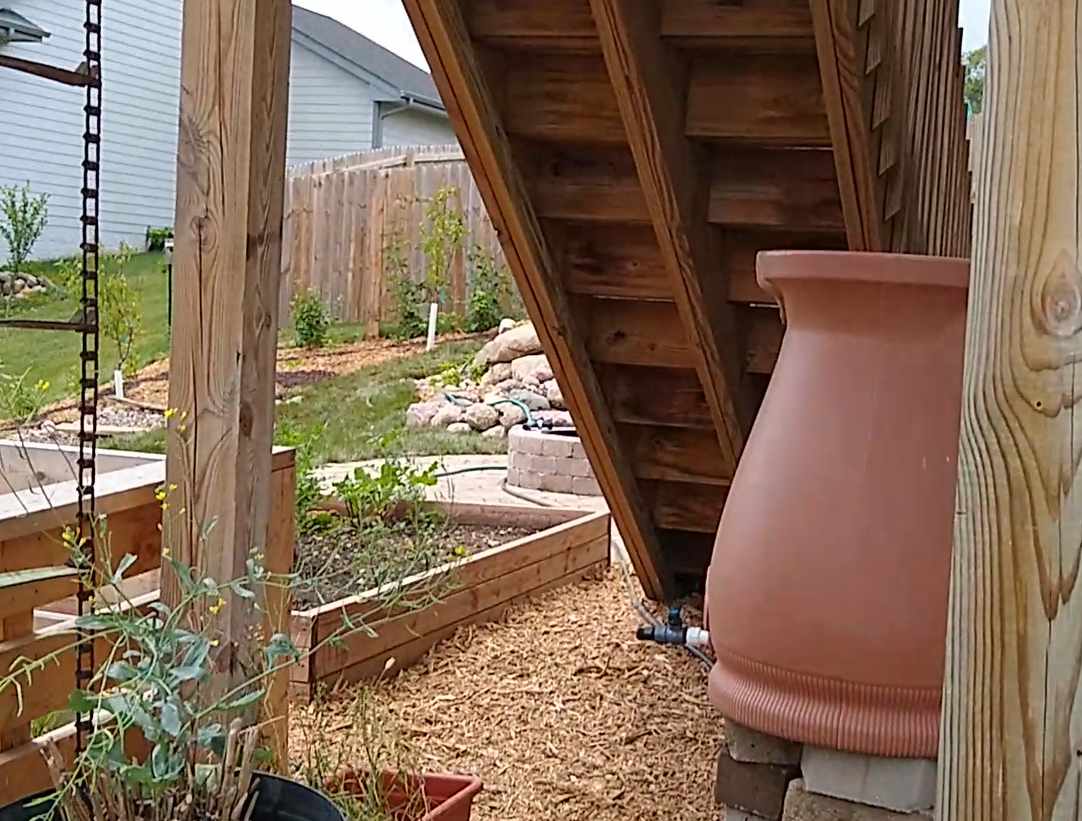 |
Dry play yard, decorative and functional stream
with a woodland adventure area behind |
Wet + Shade + High Traffic
These things never lend themselves to a healthy lawn... A lawn is definitely something the homeowners wanted out of this project for their kids' soccer and football games. But in addition to the lawn, they wanted a space for creative play, keeping or expanding the existing vegetable gardens, increasing the numbers of edible berries and plants, all while doing it in a natural and earth-friendly sort of way.
Before pics-
 |
Heavy shade, traffic and excessive moisture
make turf grass struggle to thrive |
 |
Deeper shade and low growing branches
|
 |
| Garden space, with bland spirea along the house |
These bushes on the back window were lanky and just not very interesting, they were hoping for something better, maybe even edible. The blueberries they already had were doing great! We decided on a trio of 'Regent' Serviceberry for variety, a hardy native that also produces delicious berries.
This area was also in heavy shade from a maple tree with an expansive canopy. Grass had always struggled along this access area in and out of the backyard, too. Maybe we could use the 'problem as the solution' and just take the turf grass out of the equation for this part of the yard?
Solutions-
The shade was hindering the lawn from drying out, but the cause of the initial wetness was downspouts pouring into the yard, shallow slope preventing proper drainage and a large amount of runoff from a neighboring hillside.
We could reroute the runoff from both uphill and the downspouts, utilize the
city rebate program and create multiple spaces for adventurous play, pollinator habitat and a natural feeling space that felt more like a nature park than the suburbs.
Many shrubs had volunteered along the back property line, including dogwood, mulberry and highly invasive honeysuckle. We removed most of these, except a few pagoda dogwood that happened fit where they were.
 |
| I love using the stump bucket to remove honeysuckle! |
We raised the canopy on the evergreens to open up the feel, leaving some climbing rungs for tree borne adventures. You can also see the grading for the swale that will push water to the rain garden and away from the lawn.
A designated walkway - the "jungle path" as the kids called it - was made using a darker shade of mulch, which will allow traffic in the area but keep the new plantings from being trampled.
 |
Tripod sprinklers kept the newly installed plants and sod
hydrated during the long, hot and dry peak of summer. |
 |
| Stream installed, fescue sod going in for the final touch |
 |
A rain garden captures the runoff and sinks it into the ground
instead of flooding the neighbors and storm sewer system |
Remember the shady access way where grass struggled? We created a woodland garden with a limestone path for access. We were lucky and could use mostly reclaimed limestone steppers found under the volunteer shrubs. The nearby downspouts were routed to this space where native shade loving plants won't mind the extra moisture - including ferns, sedges and wild geranium. A couple gooseberry shrubs won't mind the shade either and provide a seasonal snack for adventurous young explorers.
 |
| Shade tolerant access path planting |
In addition, the front planting island around the flagpole was overgrown with a massive burning bush (also invasive), volunteer mulberries and plastic edging that had seen better days (no before picture). Tumbled granite added an updated and durable edge to this bed. All of the existing vegetation was removed and replaced with Midwest native plants, like an Aronia bush and New Jersey Tea tree. Butterfly milkweed, rudbeckia and echinacea were among the flowering forbs, with switchgrass for height and textural contrast in the center and fronted by lower growing clumps of prairie dropseed.

The shade on this project was very welcome during this summer's heat!



























































